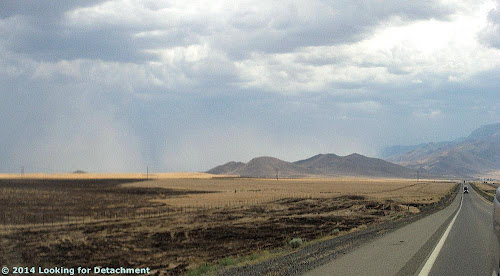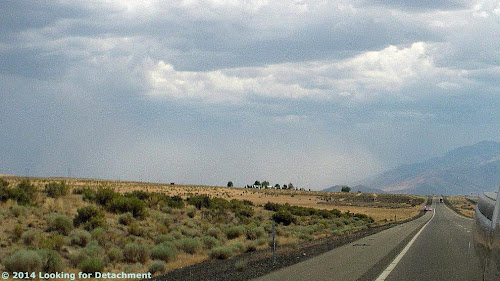At 3:37 pm, July 20th, my phone made a strange and loud noise in my pocket, and I took it out to find the first of two
emergency alerts that I would receive from the National Weather Service.
 |
| The first NWS alert, for the Lovelock area, is on the bottom. |
Besides the emergency alert sound, similar to that of
the emergency broadcast system on radio and TV, the "Severe" and "Avoid travel" were phrases that caught the attention of the two geologists working that day, geologists who were hoping to leave in about an hour, but not particularly sooner.
UPDATE 29Jul2014: Also note that the Severe Alerts above mentioned "Dust Storm," not using the word "Haboob," which
according to Wikipedia is derived from the Arabic word
habūb, meaning "blasting/drafting." (I've seen other, similar derivations and translations of Arabic words and don't know which are most accurate.) Nevertheless, as you will see below, what we were about to witness was a huge dust storm with a miles-long wall of dust, often called a haboob in many parts of the world, including Arizona.
Our first glance outside wasn't too encouraging with regard to travel.
 |
| First view of the haboob on the east side of the valley: a wall of dust coming up from the south. |
After looking around outside, we rushed to put things in order, piled into a truck, and left town. We didn't really want to hang around until 8 pm or whenever visibility would return.
To begin with, I thought the dust was a fairly localized phenomenon coming from the
Humboldt Sink, which is about 10 to 15 miles southwest of Lovelock, or perhaps it was coming from the combined Humboldt and Carson Sinks. The
Carson Sink is the very large sink for the Carson River, located 15 to 35 miles south of Lovelock, beyond the West Humboldt Range. I'd never seen the Humboldt Sink kick up quite this much dust on its own, so I had to entertain a larger possibility.
 |
| Shot of the haboob approaching Lovelock from the south. In this shot it has started to ride up over the south end of the Trinity Range beyond I-80, thereby already having overridden I-80 out near Toulon. |
 |
| Three stitched-together photos of the same wall of dust, taken at 3:52 pm as we were scrambling to leave. The dust was already encroaching onto trees usually in view to the south. |
 |
| As we got onto the on ramp for I-80, the dust looked like it would shortly pass over the Golden Gate truck stop (shown as Port of Subs and only approximately located by Google on this map) |
 |
| A first look back at the dust after getting on I-80. |
Many of the next shots (and the one above) were taken looking into the side mirror on the passenger side of the truck (the one that says "Objects In Mirror Are Closer Than They Appear"). I've reversed these mirror shots to show more accurately the shape of the hills and mountains behind us as we drove north and northeast toward Winnemucca.
 |
| Somewhere between the Oreana and Rye Patch exits, I could see that the wall of dust had gone past Coal Canyon (Google Maps location) and was steadily moving northward. |
 |
| Just past Rye Patch, it looked like the dust storm had fully moved into Rochester Canyon (Google Maps location) and possibly, though not clearly, into Limerick Canyon (marked as "Lovelock-Unionville Road" by Google on the previous map). |
 |
| Shot of the haboob from just northeast of Humboldt House. The trees are at Humboldt House; the small reddish hill on the left is one of the heap leach piles at Florida Canyon. |
When we rounded the corner at Humboldt House (
Google Maps location) and the
Florida Canyon Mine, the sight of the huge wall of dust engulfing the Trinity Range behind us reminded me of a giant pyroclastic cloud (not that I've ever seen one IRL). The dust was billowing and looked like it was eating everything it its path.
 |
| The haboob approaches a small rain shower in the Trinity Range. |
 |
| Dust in Buena Vista Valley. The TA truckstop near the Mill City exit is visible in the distance to the right (west) of I-80. |
As we went past the Unionville exit (behind us in the photo above), dust was rising from Buena Vista Valley beyond the low, brownish hills near the
Star Point Trading Post and RV park, and I thought that all we were seeing was non-haboob from Buena Vista Valley and possibly from the Carson Sink.
At this point in this photo-log, you might notice that some photos are oversharpened, due to motion, relative darkness, and an obviously improper ASA (ISO) setting by the photographer. I probably should have switched to an ASA of 800 or higher, and was probably using a normally adequate setting of 400.
 |
Another view of dust in Buena Vista Valley and the east side of the Humboldt Range. The trees are at the constantly closed Cosgrave rest stop
(Google Maps location). |
 |
A centered view of the Humboldt Range looking south-southwest down I-80.
The tiny-looking, triangular knob in the broad central part of the range is Thunder Mountain. Star Peak is the high point to the left; the high point to the right is probably Van Zant Peak. |
I could now see dust on both sides of the Humboldt Range, and I began to suspect that there was only one dust storm.
 |
| Dust now appears to be coming over the top of the Humboldt Range in the gaps between Thunder Mountain and Star and Van Zant Peaks. |
All three peaks top 9000 feet, with Star Peak coming in at 9840 ft or 2999 m. The valley floors on either side of the range are at about 4150 to 4500 feet, and Imlay sits at 4200 feet (< 1300 m) just north of the north end of the range (
Imlay at MSRMaps).
 |
| Looking back at our final view of the Humboldt Range as we approach the Rose Creek exit just east of Winnemucca. |
The haboob (above) has now moved fully into the valley of the Humboldt River at Imlay, and it looks like it's about to start riding up the south flank of the Eugene Mountains on the far right (Google Maps location of Imlay, with the Eugene Mountains to the north). Dust is coming around both sides of the Humboldt Range to potentially merge into one wall at the north end of the range. At about this time, I received the second of my wireless alerts (first image at the beginning of the post).
 |
| As we approach Winnemucca, dust is rising in Grass Valley ahead of a thunderstorm coming in from the south. |
 |
| Dust devil in Grass Valley. |
 |
| Dust in Grass Valley on the right, and what appears to be dust beyond the low, north end of the Sonoma Range, somewhere out near Golconda. |
 |
A shot more clearly showing that some of the dust is rising east of the Sonoma Range rather than being confined to Grass Valley.
This last photo was taken at 4:52 pm. |
Until we rounded the corner going into Winnemucca near the Rose Creek exit, we had experienced no wind (or very minor wind, especially compared to the usual norms), and there had been absolutely none when we left work just ahead of the wall of dust. Now, the wind was strong from the south or southeast, and we were glad to have arrived in town just barely ahead of the main part of the dust storm. I settled into the apt, and, looking out the front and back windows every now and then, I noticed persistent though mostly patchy dust and a short-term disappearance of Winnemucca Mountain to the north — nothing like the wall of dust we had seen earlier! It rained later, and the next day we found out that winds had been strong upon the arrival of the haboob in Lovelock, strong enough to knock down tree branches. Streets were wet and puddled at work the next morning, and life went back to normal, albeit with less haze and fire-related smoke, which had been prevalent before the storms.
I had immediately, upon arrival at the apt, looked up the satellite photo for the area to see if the passage of the haboob could be seen. I thought maybe it could:
 |
| Visible satellite image for 23:30 Z, or 4:30 pm PDT. |
What I noticed while running the loop that ended with this image, was that apparent wind and dust movement was to the north all along a zone across northwestern Nevada (above, from about Reno to north of Battle Mountain). Also, outward from Nevada and the Basin and Range in a very large circular "front," the many patches of combined storms, clouds, and dust appeared to be moving broadly or generally away from the center of Utah or an ill-defined area in northern Arizona. I don't know whether this was all part of the same storm system, but below I've drawn in bright cyan what I think was the approximate line of the haboob with trailing and collapsing (?) thunderstorms behind it, and I've put in a few arrows showing apparent drift of wind, dust, and clouds in bright magenta:
 |
| Cartoon of possible location of haboob across northwestern Nevada in cyan; wind directions as apparently indicated by moving dust and storms are shown by magenta arrows. These are my interpretations only and have not been verified by a meteorologist. |
Dust hit Lovelock shortly after 3:55 pm; dust was moving across I-80 in Winnemucca by 4:50 pm; dust was about to move into Gerlach in a big way
as of 5:57 pm. I didn't find a lot about the haboob online, although it was mentioned by a few local news broadcasts that I can't access, and was mentioned in
this RGJ news story. There were a
few pictures, a
blog post, and
two videos of people on I-80 driving farther into the storm than I would have thought wise. The first video in particular shows the movement of the dust storm fairly well; the second shows somewhat more prudent driving.
The original weather alert by the NWS for Churchill County "INCLUDING PYRAMID LAKE-INCLUDING THE CITIES OF. FERNLEY. FALLON. LOVELOCK. SILVER SPRINGS" and remaining in effect until 8 pm is archived
here; the original NWS alert for Humboldt County "INCLUDING THE FOLLOWING LOCATIONS. WINNEMUCCA. MCDERMITT. PARADISE VALLEY. GOLCONDA SUMMIT" and remaining in effect until 11 pm is archived
here.
How to drive in a haboob or large dust storm (
STOP DRIVING!!: DO NOT ENTER THE STORM!! DO NOT USE FLASHERS!! Pull farther off the road than shown in the above videos —
ALL the way over past the paved or flat to sloping shoulder!
READ THE PAGE AT THE LINK!!).
More about Wireless Emergency Alerts (WEA).
Wikipedia on haboobs.
The Northern Nevada Haboob (of May 22, 2014).
P.S. This is my 1004th post!































